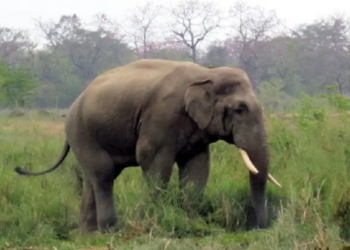Investigators have come across strong evidence showing China’s role in the growing tiger poaching in India and other tiger-habitat countries.
Recent arrests of poachers and tracking the supply chain and payment transactions have revealed that demand for felid body parts to China has seen a surge in recent years.
Tiger countries were alarmed after a surge in tiger poaching. Notably, the information gathered from the arrested poachers showed China was still the major market. Multiple routes are established for wildlife trafficking now.
“We believe China remains the primary market, where tiger bones are used in traditional medicines,” said Subharanjan Sen, Principal Chief Conservator of Forest of India’s Madhya Pradesh state.
India lost at least 100 tigers in just three years and most of them were believed to be traded in China.
Several arrests occurred in the central in the past year. Investigations found that poached tigers were smuggled to China through the north-eastern states of India Nepal and Myanmar.
One poacher named Pujari Singh told investigators that the poached tiger was traded in China through a syndicate.
Investigators busted a massive financial network used by the poachers for trading tiger parts.
Now they are analysing the bank transactions and cell records of the accused poachers.
After the arrests of the two accused –Ning San Lun and Kaplian Mung, the investigators learned about the hawala transactions in the tiger trade.
“Given the large-scale hawala operations that have surfaced, the Enforcement Directorate’s involvement has become crucial,” said one investigator.
Multiple agencies from India have been investigating the rising cases of tiger poaching, its connection to China and the big financial transactions involved. They tracked payments of around INR 75-80 million even as the transactions from the Nepal-Tibet supply chain are yet to be accounted.
After a hiatus, tiger poaching from India and other tiger habitat countries appears to be increasing thanks to the strong demand from China.
Tiger poaching in India and other countries is rising due to the increasing demand for body parts in China, according to an investigation carried out by a group of researchers from India.
All three, water, land, and air routes are being used to smuggle felid body parts to China.
“The illegal products from other tiger-ranging countries make their way to China via an international trading network. Trafficked tiger products are primarily used as decorative materials or as an ingredient in Chinese traditional medicines and the production of wine,” the researchers wrote.
After new supply chain routes were found, Vietnam is rumoured to be the new market for tigers from India. However, officials are still focused on China.
“Our investigation has traced the recent tiger poaching network up to Myanmar. Since Myanmar is primarily a transit nation, the final destination is likely China, as it often is,” said Ritesh Sarothiya, head of Madhya Pradesh’s Special Task Force.
Other tiger range countries such as Thailand, Indonesia, and Malaysia too have become vulnerable to poaching driven by the increased demand in China.
Indonesia is facing the uphill challenge of protecting the critically endangered Sumatran tiger.
“Poaching and illegal trade remain perilous threats to the survival of wild tigers. Decades of effort, investments and pledges have not eased pressure on wild tiger populations,” said TRAFFIC, a wildlife trade monitoring group.
Tigers in Vietnam, Laos and Cambodia were extinct due to poaching for their use in traditional Chinese medicine. Now the surge in the demand in China has led poachers to focus on Thailand and Malaysia, said John Goodrich, Chief Scientist at Panthera, a conservation organisation.
“Poaching gangs on the hunt for tiger body parts are emptying forests of these magnificent cats in Malaysia to feed a demand in Vietnam and China that shows no signs of slowing,” he said.
Environmental Investigation Agency, which investigates and campaigns against environmental crimes, expressed concerns over the negligence of the Chinese government.
“In the primary tiger consumer country of China, the silence from the highest levels of Government on the matter is deafening,” it said.
“The scale of demand and an apparent preference for wild tiger meant there has been enormous pressure on populations in neighbouring countries, with poachers channelling illegally sourced wild tiger into China.”









Comment